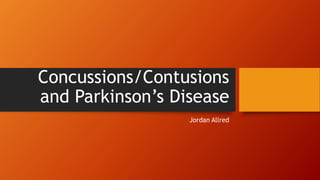
Concussions and Parkinson's Disease
- 2. What is a Concussion and Contusion? • A concussion is the less serious of the two conditions and does not involve injury to the brain. A contusion, however, is a physical bruising of the brain tissue. • Brain contusion is usually accompanied by a skull fracture. • Both are forms of trauma.
- 3. Etiology • A blow to the head caused by an object, fall, or other trauma such as an automobile accident can cause a concussion or contusion. • In sports, football has been in the news the most for concussions as helmet to helmet hits have proven to be traumatic.
- 4. Symptoms • Both concussions and contusions cause a disruption in electrical activity. • Immediate unconsciousness (knocked out) • Amnesia (loss of memory) • Headache, blurred vision, and irritability. • Vomiting • Contusion only- hematoma, increased ICP, permanent brain damage, and a Coup (COO) Lesion.
- 5. Diagnosis • History of the injury • Neurologic examination • Cranial x-ray • CT (Computerized Axial Tomography) • MRI (Magnetic Resonance Imaging)
- 6. Treatment • Concussion- bed rest in a quiet area with observation. The individual must woken every two to four hours to be observed for changes in consciousness, eye pupil size, mood, and behavior. • Contusion- the individual should be hospitalized for continuous monitoring. • Analgesic, sedative, and stimulant medications should not be given to individuals with head injuries because they can mask the symptoms. • No two concussions are the same.
- 7. Treatment • New treatments continue to be developed such as baseline testing for athletes called Impact. Once there is a possible concussion and retake the test. • Some athletic trainers are using exercise to observe mild case patients as they can test their balance and watch to see if they are still suffering symptoms that were otherwise difficult to see.
- 8. Prevention • Wearing a seatbelt in an automobile • Wearing a helmet for recreational activities (riding a bike). • Preventing falls by removing clutter and slippery surfaces. • Helmets in football have been shown ineffective in preventing concussions or contusions, rather they prevent skull fractures (reduced the risk of concussion by only 20% in a study performed by Florida State University.)
- 9. Sports • For both boxers, MMA fighters, and football players traumatic brain injuries are common place. • The NFL is the subject of the upcoming movie Concussion along with a major lawsuit from former players. . • Scientists have discovered a link between concussions and the later in life disease Chronic Traumatic Encephalopathy (CTE). • This disease has led to the suicide deaths of at least 50 former players.
- 10. Statistics • 3,800,000 concussions reported in 2012, double what was reported in 2002 • 33% of all sports concussions happen at practice • 47% of all reported sports concussions occur during high school football • 1 in 5 high school athletes will sustain a sports concussion during the season • 4 to 5 million concussions occur annually, with rising numbers among middle school athletes • 90% of most diagnosed concussions do not involve a loss of consciousness • An estimated 5.3 million Americans live with a traumatic brain injury- related disability (CDC)
- 12. Parkinson’s Disease • Parkinson’s Disease is a slow, progressive brain degeneration, usually developing in individuals in their late 50s and 60s. • Affects men more often than it does women. • Not much is known about this disease, it is very mysterious.
- 13. Etiology of Parkinson’s • The cause is unknown. • Individuals with Parkinson’s Disease have been found to have a deficiency of the neurotransmitter dopamine in the brain. • Genetics and the environment have been found to play factors in the disease.
- 14. Symptoms of Parkinson’s • Rigidity and immobility of the hands. • A slow, hard to understand speech pattern. • A fine tremor in the hands described as a pill-rolling motion of the fingers. • An expressionless facial appearance with a fixed stare and infrequent blinking called Parkinson’s facies. • An abnormal bent forward posture that includes a bowed head and flexed arms.
- 15. Symptoms of Parkinson’s cont. • After being diagnosed with Parkinson’s anger, frustration, and depression are normal. • A peculiar gait of short, fast-running steps due to the abnormal posture that makes the individual tend to stumble forward, leading to frequent falls.
- 16. Diagnosis of Parkinson’s • Thorough history and a physical exam. • Patient has Bradykinesia (slowness of movement) • At least one of the following: muscle rigidity, resting tremor, and/or postural instability. • Also dopamine levels can be used as a chemical test.
- 17. Treatment of Parkinson’s • The only treatment for Parkinson’s is symptomatic as there is no cure. • Dopamine replacement medications can be used, while they do not stop the progression of the disease. • Psychological support and physical therapy for muscle soreness are also helpful.
- 18. Prevention of Parkinson’s • Since there is no known cause of this disease there are not any prevention methods at this time. • As a person ages they can continue to receive checkups from their physician to catch the disease early and began treating the symptoms.
- 19. Alternative Medicine and Parkinson’s • Massage and acupuncture have been found by the Mayo Clinic to aid in dealing with symptoms. • Tai Chi, yoga, and meditation have also been found to help with relaxing the individual and also increasing dopamine levels without medication. • Mixtures of herbs, including gou teng, has shown to help patients sleep well and have more understandable speech patterns while not exhibiting the same ill side effects that prescription medications have.
- 20. How the brain is affected by Parkinson’s